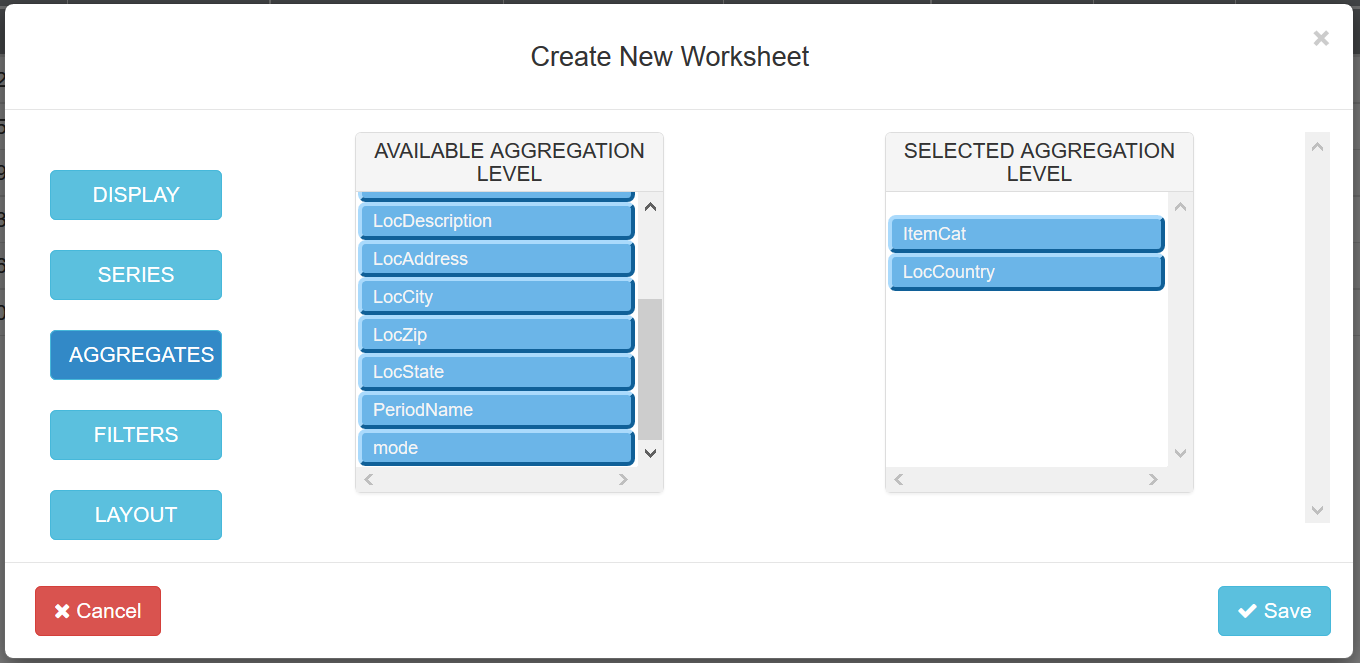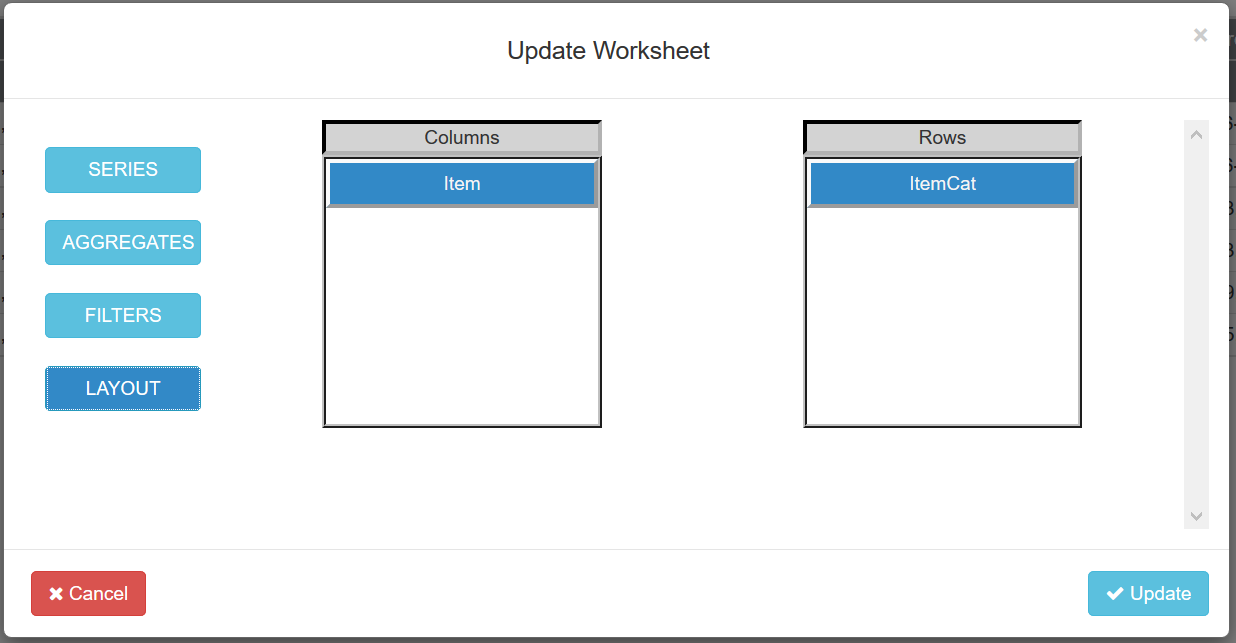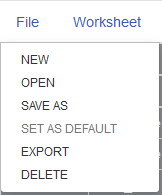Worksheet¶
![]() Worksheets are custom reports in which user can select what data to show for what item/customer/facilities and how it will be aggregated.
Worksheets are custom reports in which user can select what data to show for what item/customer/facilities and how it will be aggregated.

DISPLAY¶

Field Details:
- Worksheet Name: User needs to provide a unique name for each worksheet in the model.
- Report: A worksheet can be of 2 types:
- Demand Analysis: When user wants to create a report based on customer aggregation.
- Throughput Analysis: When user wants to generate report based on facility/item/mode/period.
SERIES¶
Series are different network metrics like weight/cubic/quantity/cost.

User needs to choose what data needs to be show in worksheet.
Series for Throughput Analysis type worksheet are:
- Secondary Flow Units: It represent total customer demand in units, calculated from Flow Units of Customer Flows table.
- Secondary Flow Weight: It represent total customer demand in weight, calculated from Flow Weight of Customer Flows table.
- Secondary Flow Cubic: It represents total customer demand in volume, calculated from Flow Cubic of Customer Flows table.
- Secondary Tpt Cost: It represents secondary transportation cost, calculated from Flow Transportation Cost of Customer Flows table.
- Secondary Duty Cost: It represents secondary duty cost, calculated from Flow Duty Cost of Customer Flows table.
- Secondary Sourcing Cost: It represents secondary sourcing cost, calculated from Flow Sourcing Cost of Customer Flows table.
- Secondary Shipment Fixed Cost: It represent fixed cost of secondary shipments, calculated from Total Shipment Cost of Shipment Output table.
- Total Secondary Cost: It is calculated as: Secondary Tpt Cost + Secondary Duty Cost + Secondary Sourcing Cost + Secondary Shipment Fixed Cost.
- Primary Flow Units: It represent total interfacility flow in units, calculated from Flow Units of Interfacility Flows table.
- Primary Flow Weight: It represent total interfacility flow in weight, calculated from Flow Weight of Interfacility Flows table.
- Primary Flow Cubic: It represents total interfacility flow in volume, calculated from Flow Cubic of Interfacility Flows table.
- Primary Tpt Cost: It represents interfacility transportation cost, calculated from Flow Transportation Cost of Interfacility Flows table.
- Primary Duty Cost: It represents interfacility duty cost, calculated from Flow Duty Cost of Interfacility Flows table.
- Primary Sourcing Cost: It represents interfacility sourcing cost, calculated from Flow Sourcing Cost of Interfacility Flows table.
- Primary Shipment Fixed Cost: It represent fixed cost of interfacility shipments, calculated from Total Shipment Cost of Shipment Output table.
- Total Primary Cost: It is calculated as: Primary Tpt Cost + Primary Duty Cost + Primary Sourcing Cost + Primary Shipment Fixed Cost.
- Total Flow Units: It represent total outbound flow in units, calculated as Secondary Flow Units + Primary Flow Units.
- Total Flow Weight: It represent total outbound flow in weight, calculated as Secondary Flow Weight + Primary Flow Weight.
- Total Avg Tpt Cost: It represents outbound transportation cost, calculated as Secondary Tpt Cost + Primary Tpt Cost.
- Total Duty Cost: It represents outbound duty cost, calculated as Secondary Duty Cost + Primary Dusty Cost.
- Total Sourcing Cost: It represents outbound sourcing cost, calculated as Secondary Sourcing Cost + Primary Sourcing Cost.
- Total Shipment Fixed Cost: It represent fixed cost of outbound shipments, calculated as Secondary Shipment Fixed Cost + Primary Shipment Fixed Cost.
- Total Transportation Cost: It is calculated as: Total Avg Tpt Cost + Total Duty Cost + Total Sourcing Cost + Total Shipment Fixed Cost.
- Inbound Flow Units: It is total inbound flow in units.
- Inbound Flow Volume: It is total inbound flow in volume.
- Inbound Flow Cubic: It is total inbound flow in cubic.
- Flow Inbound Warehousing Cost: It is total inbound handling cost, calculated from Flow Inbound Warehousing Cost of Inventory Output table.
- Flow Outbound Warehousing Cost: It is total outbound handling cost, calculated from Flow Outbound Warehousing Cost of Inventory Output table.
- Total Handling Cost: It is calculated as Flow Inbound Warehousing Cost + Flow Outbound Warehousing Cost.
- Total Holding Cost: It is total inventory holding cost, calculated from Total Holding Cost of Inventory Output table.
- Total Storage Cost: It is total storage cost, calculated from Total Storage Cost of Inventory Output table.
- Total Inventory Cost: It is calculated as Total Holding Cost + Total Storage Cost.
- Fixed Opening Cost: It is facility fixed opening cost which is proportionally split at lower level based on facility throughput in units.
- Production Quantity: It is total quantity produced/procured in units, calculated from Production Quantity of Production Output table.
- Production Weight: It is total quantity produced/procured in weight, calculated from Production Weight of Production Output table.
- Production Cubic: It is total quantity produced/procured in volume, calculated from Production Cubic of Production Output table.
- Production Cost: It is total cost of production, calculated from Production Cost of Production Output table.
- Total Network Cost: It is calculated as: Production Cost + Fixed Opening Cost + Total Inventory Cost + Total Handling Cost + Total Transportation Cost, it includes all the cost components.
- Total Revenue: It is total revenue generated, calculated using Item Price of Item table.
- Total Profit: It is calculated as Total Revenue – Total Network Cost.
Series for Demand Analysis type worksheet are:
- Total Quantity: It is total demand in units.
- Total Weight: It is total demand in weight.
- Total Cubic: It is total demand in cubes.
- Total Secondary Cost: It is total secondary cost required to meet customer demand, it includes Flow Transportation Cost, Flow Duty Cost, Flow Sourcing Cost of Customer Flows table and Total Shipment Cost of Shipment Output table.
- Total Primary Cost: It is total interfacility cost required to meet customer demand, it includes Flow Transportation Cost, Flow Duty Cost, Flow Sourcing Cost of Interfacility Flows table and Total Shipment Cost of Shipment Output table.
- Total Transportation Cost: It is calculated as Total Secondary Cost + Total Primary Cost.
- Total Inventory Cost: It includes inventory holding cost and storage cost split proportionally among item/customers as per flow units.
- Total Handling Cost: It includes flow inbound and outbound warehousing cost split proportionally among item/customers as per flow units.
- Facility Fixed Cost: It includes fixed facility cost split proportionally among item/customers as per flow units.
- Production Cost: It includes production cost split proportionally among customers as per flow units.
- Total Network Cost: It is calculated as Total Transportation Cost + Total Inventory Cost + Total Handling Cost + Facility Fixed Cost + Production Cost.
- Total Revenue: It is total revenue generated, calculated using Item Price of Item** table.
- Total Profit: It is calculated as Total Revenue – Total Network Cost.
AGGREGATION¶
User may choose how to aggregate data, for instance one user may look at country level data and other may look at region specific data. User may aggregate based on user defined column in Item or Location table, period, mode, geography etc.




